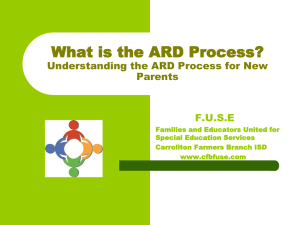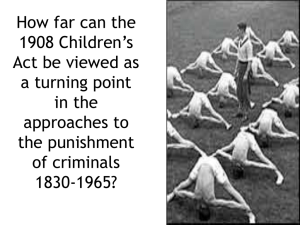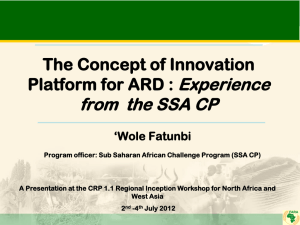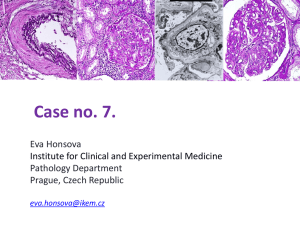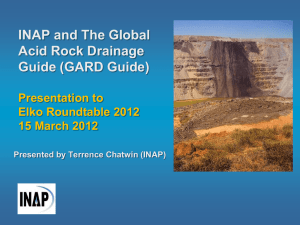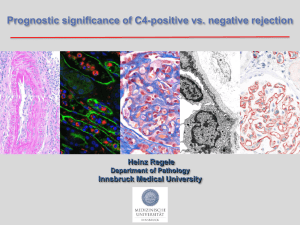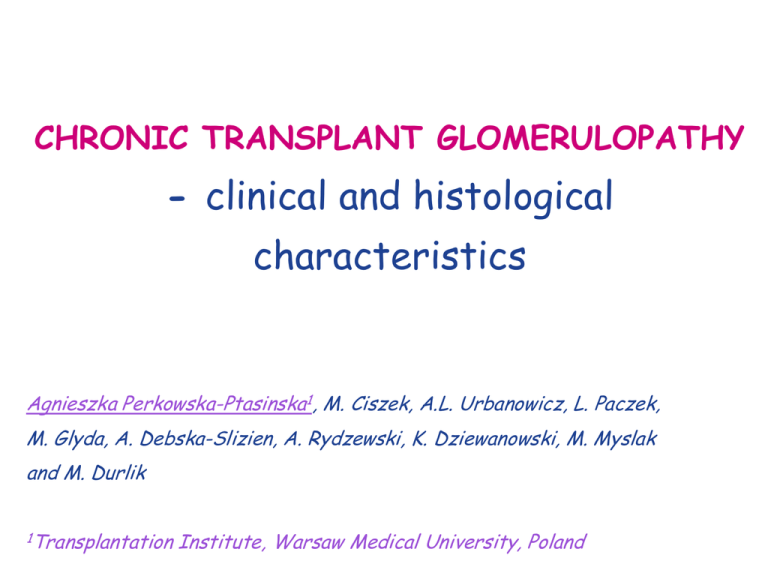
CHRONIC TRANSPLANT GLOMERULOPATHY
- clinical and histological
characteristics
Agnieszka Perkowska-Ptasinska1, M. Ciszek, A.L. Urbanowicz, L. Paczek,
M. Glyda, A. Debska-Slizien, A. Rydzewski, K. Dziewanowski, M. Myslak
and M. Durlik
1Transplantation
Institute, Warsaw Medical University, Poland
CHRONIC TRANSPLANT GLOMERULOPATHY
MORPHOLOGY:
double contours of glomerular
capillaries,
no IF/EM deposits
CLINICALLY:
proteinuria, hypertension,
declining graft function and
graft loss
Habib 1993;
Regele J Am Soc Nephrol 2002;
Sijpkens Ki 2004;
Gloor AJT 2006;
Sis AJT 2007;
Gloor AJT 2007;
Cosio AJT 2008;
CHRONIC TRANSPLANT GLOMERULOPATHY
• rare before 6 months after Tx,
• the incidence rises from 1.0-4.0% at 1 year to 20% at 5 years
• more common in patients with:
- historical or ongoing acute rejection
- DSA (especially against HLA II Ag )
- ABO incompatibility with a donor
- non-HLA reactive Ab (MICA, anti-endothelial cell Ab,
anti-angiotensin type 1 receptor Ab)
Dinavahii J AM Soc Nephrol 2011
WillicombeTransplantation 2012
Dragun Curr Opin Organ Transplant. 2012
CHRONIC TRANSPLANT GLOMERULOPATHY
Lesions that accompany TG:
PTCitis,
glomerulitis
C4d in PTCs
,
Regele J AM Soc Nephrol 2002;
Shimizu KI 2002;
Aita Clin Transplant 2005;
Gloor AJT 2007; Sis AJT 2007,
Perkowska Trans Proc 2009
what about the morphology
of the interstitium, tubules, arteries, arterioles?
The retrospective study of:
159 patients with TG and 85 recipients without TG, but with other
chronic changes in the graft biopsy (IF/TA and/or chronic vascular
lesions)
median observational time: 118 months (range 39-270 months)
median time from Tx to biopsy: 55 months (range 0.4-243 months)
F:102, M:142
AIM:
to give a detailed morphological characteristics of TG
to search for potential impact of each of studied lesions on graft survival
Methods:
the analysis of clinical and histological (LM) data
including C4d deposition in PTCs and glomeruli (IHC on paraffin sections)
Methods
Light microscopical evaluation based on Banff classification
Compartment
additional parameters (added to Banff criterias)
glomeruli
•linear C4d in glomerular capillaries,
•thrombi,
•mesangiolysis,
•globally and segmentally sclerosed glomeruli (%)
arteries
arterioles
arteriosclerosis without the multiplication of elastic lamina
•subendothelial sclerotization,
•smooth muscle cells hyperplasia,
•thrombi
interstitium
• PTCs’ dilatation
TG vs non-TG cases
light microscopical evaluation
TG
Banff criteria + additional parameters
Non-TG
p
C4d in PTCs
42.9%
1,3%
<0.0001
C4d in PTCs and glomerular capillaries
6.5%
0
0.03
C4d only in glomerular capillaries
0
0
NS
PTC-itis
40.9%
11.8%
<0.0001
PTCs’ dilatation
35.9%
10.6%
<0.0001
Acute interstitial inflammation („i”)
30.8%
10.6%
<0.0001
Total interstitial inflammation („ti”)
81.8%
68.2%
0.03
The percantage of globally/segmentally sclerosed glomeruli
30.2 ± 21.7
19.6 ± 21.2
<0.0001
Mesangiolysis
39%
11.8%
<0.0001
Increase in mesangial celullarity
39%
8.2%
<0.0001
Increase in mesangial matrix volume
48.4%
27.1%
0.002
Glomerulitis
61%
7.1%
<0.0001
Tubulitis
31.5%
10.6%
0.0002
Endarteritis
9.8%
0
0.003
Arteriosclerosis without the multiplication of elastic lamina
18.9%
3.6%
0.001
Arteriosclerosis with the multiplication of elastic lamina
28.7%
22.9%
NS
Arteriolar sclerotization
47.2%
18.8%
<0.0001
Arteriolar SMCs hyperplasia/hypertrophy
39.6%
11.8%
<0.0001
Arteriolar wall hyalinisation
86.8%
77.7%
NS
Correlation between TG
and other morphological lesions
TG
rs (p)
C4d in PTCs
0.37 (<0.0001)
increase in mesangial matrix
0.32 (<0.0001)
increase in mesangial cellularity
0.4 (<0.0001)
segmentally and globally sclerosed glomeruli (%)
0.31 (<0.0001)
arteriolosclerosis
0.33 (<0,0001)
PTC-itis
0.27 (<0.0001)
PTCs’ dilatation
0.26 (<0.0001)
linear C4d deposition in glomerular capillaries
0.09 (0.2)
arteriolar SMCs hyperplasia/hypertrophy
0.26 (<0.0001)
„ti” lesion
0.2 (0.002)
tubulitis
0.2 (0.002)
arteriosclerosis without the multiplication of elastic lamina
0.21 (0.002)
„t” lesion
0.15 (0.03)
glomerulitis
0.15 (0.02)
probability
graft survival in TG vs non-TG group
months
Non-TG group
TG group
probability
probability
Patients’ survival
months
non-TG group
TG group
months
without graft loss
with graft loss
TG group - graft survival
univariate analysis,
PARAMETER
Weibull regression model
HR
95% CI
p
>1 Tx
1.5
1.1-2.2
0.02
recipient’s age at the time of Tx >30y
5.3
0.4-0.9
0.02
donor’s age at the time of Tx >30y
2.0
1.3-3.3
0.003
TG recognition before 44th month after Tx
6.4
4.6-9.0
<0.001
TG recognition between 44-89th month after Tx
2.6
1.8-3.6
<0.001
PTCs’ dilatation
1.5
1.0-2.2
0.05
Acute interstitial inflammation („i”)
1.7
1.1-2.5
0.02
AS without the multiplication of elastica
1.7
1.1-2.7
0.04
Thrombi in glomerular capillaries
3.7
1.7-8.0
0.001
C4d in PTCs
0.9
0.6-1.3
NS
C4d in glomerular capillaries (linear deposits)
1.4
0.6-3.3
NS
TG group - graft survival
PARAMETERS included
in the BEST
multivariate regression
model
multivariate
analysis,
Weibull regression
model
HR
95% CI
p
C4d in PTCs
1.1
0.8-1.4
0.68
AS without
multiplication of elastica
1.5
1.1-2.1
0.02
TG recognition before
44th month after Tx vs
base level
5.3
3.87.4
<0.01
TG recognition between
44-89th month after Tx
vs base level
1.9
1.4-2.6
<0.01
At least moderate
interstitial inflammation
(Banff ti2+3)
1.2
0.8-1.7
0.47
Mild interstitial
inflammation (Banff ti1)
0.7
0.5-1.0
0.06
Recipient’s age at the
time of Tx >30y
1.7
1.3-2.3
<0.01
Thrombi in glomerular
capillaries
2.2
1.1-4.2
0.02
TG C4d (+) vs TG C4d (-)
clinical variables
recipient’s sex
recipient’s age
at the time of Tx
TG C4d (-)
TG C4d (+)
F: 50%
F: 27.27%
M: 50%
M: 72.73%
40.1 ± 12.0
34.0 ± 10.7
No significant difference in the:
- level of proteinuria,
- number of current transplantation,
- number of HLA mismatches,
- percentage of highly (>50%) immunized recipients,
- level of immunosupression,
- time interval between Tx and recognition of TG.
- donor’s age and sex,
p
0.005
0.002
TG C4d (+) vs TG C4d (-)
histological
parameters
TG C4d (+)
TG C4d (-)
p
PTC’s dilatation
60.61%
17.05%
<0.0001
PTC-itis
60.61%
26.14%
<0.0001
10%
0
0.01
PTC-itis
with
neutrophils
pathologial recognitions
TG C4d (+)
TG C4d (-)
p
OR (95%CI)
acute T-cell mediated
rejection (type I,II)
27.66%
10.77%
0.03
3.17 (1.15-8.71)
CONCLUSIONS: TG vs non-TG group differ
clinically
TG exerts a negative impact on both recipients’ and grafts’ survival
The earlier TG development is associated with worse prognosis
as for the graft survival
morphologically
TG is associated with a spectrum of both acute and chronic
inflammatory as well as structural changes in glomeruli, tubules,
arteries and arterioles. Among these lesions AS without elastica
multiplication and glomerular thrombi are independent risk factors
for the graft loss
PTC-itis, the presence of neutrophils in PTCs and PTCs’ dilatation
are more common in C4d(+) TG cases
CONCLUSIONS:
Chronic VASCULAR lesions associated with TG
ARTERIOLAR SUBENDOTHELIAL
SCLEROTIZATION
AND
ARTERIOLAR WALL SMCs
HYPERTROPHY/HYPERPLASIA
- very few publications,
- documented as a feature of thrombotic
microangiopathies in native kidneys
(antiphospholipid syndrome,LN,
malignant hypertension, scleroderma,HUS)
Caetano Hypertension 2001
Nochy J Am Soc Nephrol 1999
Ruggenenti Am J Kidn Dis 1996
CONCLUSIONS:
Chronic VASCULAR lesions associated with TG
ARTERIOSCLEROSIS WITHOUT THE
MULTIPLICATION OF ELASTIC LAMINA
(proliferative arteriopathy)
Characteristic for dynamic fibrotic tissue
proliferation in the intima typical of
inflammatory and thrombotic vasculopathies
in renal transplants: one study???
Wieczorek AJT 2006
EXERTS NEGATIVE IMPACT
ON GRAFT SURVIVAL
CONCLUSIONS
TG is commonly associated with arterial
and arteriolar lesions that share the
same pathogenesis, evolve on the
background of chronic endothelial injury,
most probable Ab-mediated and/or TMA
related



